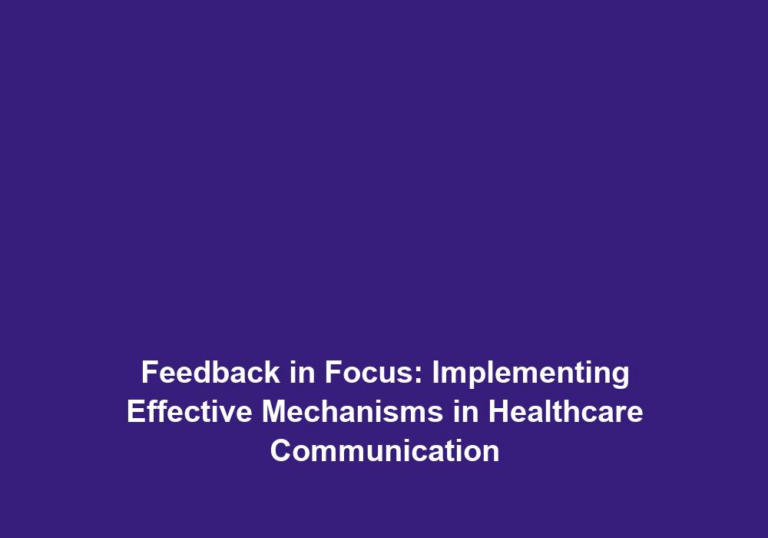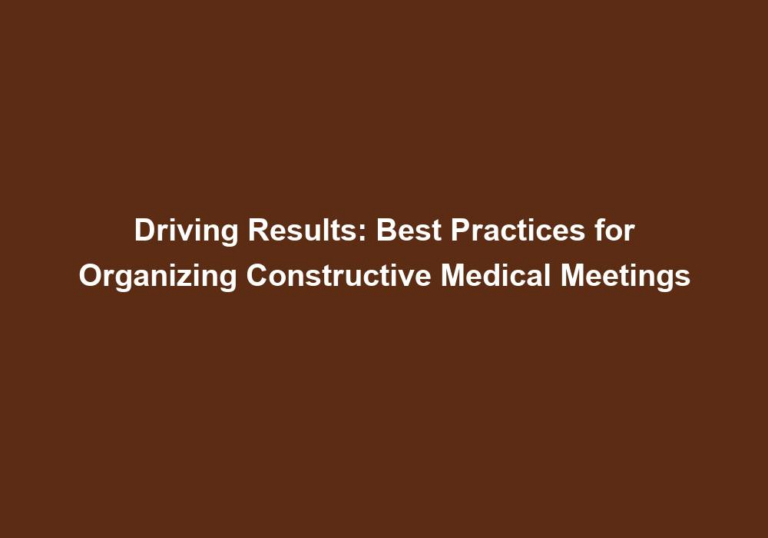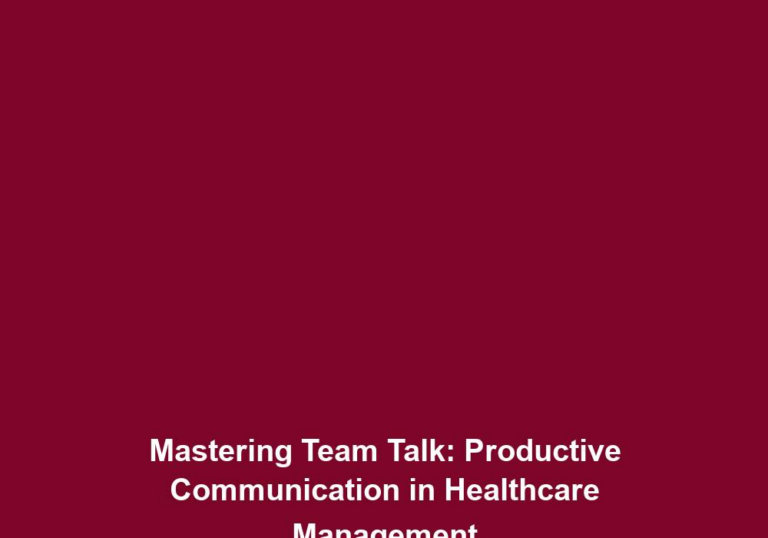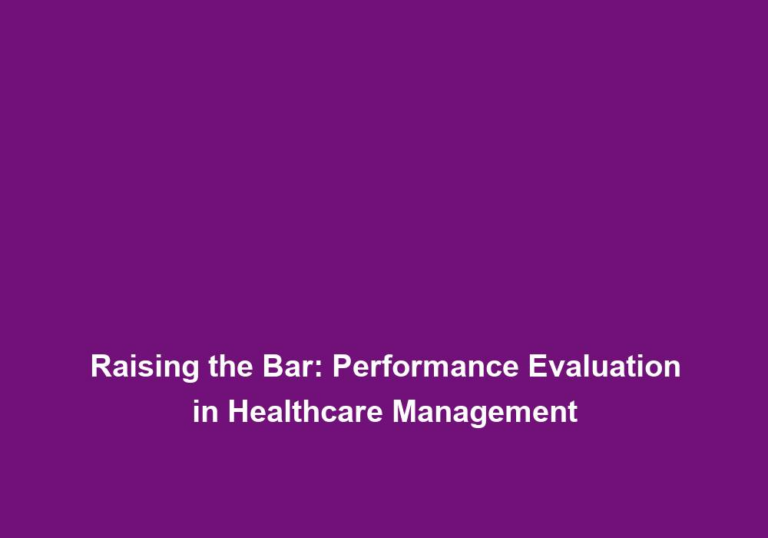From Insights to Action: Harnessing Effective Feedback Channels in Healthcare
In the healthcare industry, feedback plays a crucial role in improving patient outcomes, enhancing service quality, and driving organizational growth. By actively seeking and leveraging feedback, healthcare providers can gain valuable insights that enable them to make informed decisions and take action to address any shortcomings. In this article, we will explore the importance of effective feedback channels in healthcare and discuss strategies for harnessing these channels to drive meaningful change.
Why Feedback Matters in Healthcare
Feedback is a powerful tool that allows healthcare providers to continuously monitor and improve their performance. It provides a clear understanding of patient experiences, identifies areas for improvement, and informs decision-making processes. Effective feedback channels facilitate a culture of continuous improvement by encouraging open communication, fostering patient engagement, and ensuring that the voices of all stakeholders are heard.
Enhancing Patient Satisfaction
One of the primary benefits of feedback in healthcare is its ability to enhance patient satisfaction. By actively seeking feedback, healthcare providers can understand patient needs, preferences, and concerns. This information enables them to tailor their services to meet patient expectations, ultimately leading to higher levels of patient satisfaction. Additionally, addressing and resolving patient complaints or issues through feedback channels demonstrates a commitment to patient-centered care and strengthens the patient-provider relationship.
To enhance patient satisfaction through feedback channels, healthcare providers can:
- Implement regular patient surveys to gather feedback on their experiences.
- Offer multiple channels for providing feedback, such as online forms, surveys, suggestion boxes, or dedicated feedback hotlines.
- Actively listen to patient feedback and take prompt action to address any concerns or issues raised.
- Provide personalized responses to patient feedback to show that their voices are heard and valued.
Identifying Areas for Improvement
Feedback serves as a valuable source of information for identifying areas of improvement within healthcare organizations. By analyzing feedback data, providers can uncover recurring themes, patterns, or trends that highlight potential gaps in service delivery or operational processes. Whether it is long wait times, lack of communication, or issues with information sharing, feedback allows healthcare providers to pinpoint areas that require attention and implement targeted improvements.
To effectively identify areas for improvement through feedback channels, healthcare providers can:
- Regularly review and analyze feedback data to identify trends and patterns.
- Use analytical tools or software to gain insights into key performance indicators, patient satisfaction scores, and other relevant metrics.
- Conduct root cause analysis to understand the underlying reasons for identified issues.
- Engage with staff and patients to gather additional insights and suggestions for improvement.
Empowering Staff Engagement
Feedback not only benefits patients but also empowers healthcare staff. By actively seeking feedback from employees, organizations can foster a culture of engagement, collaboration, and continuous learning. Staff feedback provides insight into the effectiveness of training programs, highlights challenges faced by healthcare professionals, and allows for the recognition of exemplary performance. This feedback loop helps increase staff morale, job satisfaction, and overall productivity.
To empower staff engagement through feedback channels, healthcare providers can:
- Create a safe and supportive environment where employees feel comfortable providing feedback.
- Regularly solicit feedback from staff through surveys, suggestion boxes, or dedicated communication channels.
- Actively listen to staff feedback and take action to address any concerns or suggestions.
- Recognize and reward staff members for their contributions and suggestions for improvement.
Establishing Effective Feedback Channels
To harness the power of feedback, healthcare providers must establish effective feedback channels. These channels must be easily accessible, user-friendly, and encourage open and honest communication. Here are some strategies to consider when designing feedback channels:
1. Multiple Feedback Options
Offering multiple feedback options allows patients and staff to provide feedback in a way that suits their preferences. This may include online forms, surveys, suggestion boxes, or dedicated feedback hotlines. By providing a variety of options, healthcare organizations can capture feedback from a diverse range of individuals and ensure accessibility for all.
Having multiple feedback options ensures that healthcare providers receive feedback from a wider audience and different perspectives, leading to a more comprehensive understanding of patient and staff experiences. It also allows individuals to choose the method that they are most comfortable with, increasing the likelihood of receiving valuable feedback.
2. Real-Time Feedback
Real-time feedback channels enable immediate response and action. Implementing tools such as mobile apps or online platforms allows patients and staff to provide feedback instantly, ensuring that issues are addressed promptly. Real-time feedback demonstrates a commitment to responsiveness and enables healthcare providers to take immediate action when necessary.
Real-time feedback is particularly valuable in situations where immediate attention is required, such as addressing urgent patient concerns or resolving issues with service delivery. By allowing individuals to provide feedback in the moment, healthcare providers can quickly identify and address problems, leading to improved patient experiences and increased staff satisfaction.
3. Anonymous Feedback
Anonymous feedback provides individuals with the freedom to express their thoughts, concerns, or suggestions without fear of reprisal. This can encourage more honest and open feedback, enabling healthcare organizations to identify and address systemic issues that may otherwise go unreported. However, it is important to strike a balance between anonymity and accountability to ensure the integrity of the feedback received.
Anonymous feedback allows individuals to share their experiences and opinions without the fear of negative consequences. This can lead to a more accurate representation of the challenges and issues faced by patients and staff. Healthcare providers should carefully consider the implementation of anonymous feedback channels, ensuring that appropriate measures are in place to prevent misuse or abuse.
4. Regular Communication
Establishing regular communication channels, such as newsletters or email updates, helps keep patients and staff informed about the actions taken based on feedback received. This demonstrates transparency and shows that feedback is valued. It also provides an opportunity to share success stories, showcase improvements, and seek further input or suggestions.
Regular communication is essential for maintaining an ongoing dialogue with patients and staff. By keeping individuals informed about the outcomes and actions resulting from their feedback, healthcare providers can demonstrate that their voices are heard and that their feedback has a meaningful impact. It also allows for the celebration of successes and encourages continued engagement and participation in the feedback process.
Analyzing and Acting on Feedback
Collecting feedback is only the first step towards driving meaningful change in healthcare. The true value lies in analyzing and acting on the feedback received. Here are some strategies to consider:
1. Data Analysis
Feedback data should be analyzed regularly to identify trends, patterns, and areas for improvement. By using analytical tools or software, healthcare providers can gain insights into key performance indicators, patient satisfaction scores, and other relevant metrics. This analysis helps prioritize areas for improvement and guides decision-making processes.
Data analysis is crucial for transforming raw feedback data into actionable insights. By identifying common themes or issues, healthcare providers can prioritize their efforts and allocate resources effectively. It also allows for the identification of emerging trends and the ability to proactively address potential issues before they escalate.
2. Action Planning
Based on the insights gained from feedback analysis, healthcare organizations should develop action plans to address identified areas for improvement. These plans should be specific, measurable, achievable, relevant, and time-bound (SMART). Assigning responsibilities, setting targets, and establishing timelines ensures accountability and drives progress towards desired outcomes.
Action planning is essential for translating feedback into tangible changes within healthcare organizations. By setting clear goals and defining actionable steps, healthcare providers can ensure that feedback leads to meaningful improvements. Regularly reviewing and updating action plans helps monitor progress and adjust strategies as needed.
3. Continuous Monitoring
Feedback channels should be continuously monitored to assess the impact of implemented changes and identify any emerging issues. Regularly reviewing feedback data allows healthcare providers to track progress, make necessary adjustments, and ensure sustained improvement over time.
Continuous monitoring ensures that feedback remains an ongoing process within healthcare organizations. By regularly assessing the effectiveness of implemented changes, healthcare providers can identify areas that require further attention and make necessary adjustments. It also allows for the identification of new challenges or issues that may arise over time.
4. Feedback Loop Closure
Closing the feedback loop is essential to complete the feedback process. Healthcare organizations should communicate outcomes and actions taken based on the feedback received, both internally and externally. This closure demonstrates a commitment to transparency, recognizes the value of feedback, and encourages ongoing engagement from patients and staff.
Feedback loop closure provides individuals with a sense of closure and demonstrates that their feedback has been listened to and acted upon. By communicating the outcomes and actions resulting from the feedback received, healthcare providers can provide transparency and accountability. It also reinforces the importance of feedback and encourages individuals to continue providing their insights and suggestions.
Conclusion
Harnessing effective feedback channels in healthcare is vital for driving positive change and improving patient outcomes. By actively seeking feedback, healthcare providers can enhance patient satisfaction, identify areas for improvement, empower staff, and continuously improve their services. Establishing accessible and user-friendly feedback channels, analyzing feedback data, and taking meaningful action are key steps towards harnessing the power of feedback in healthcare. Let us embrace the value of feedback and work towards building a patient-centered healthcare system that thrives on continuous improvement.






